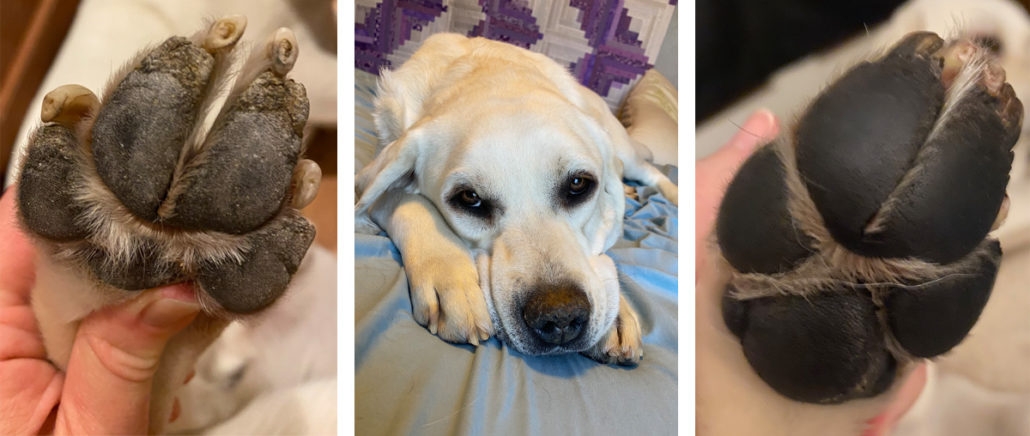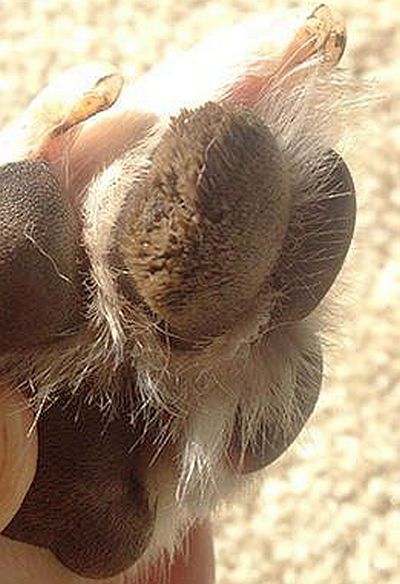

What is Hyperkeratosis in Dogs?
Understanding Hyperkeratosis in Dogs
Hyperkeratosis is a condition that affects the skin of dogs. It causes an abnormal thickening and hardening of the outermost layer of the skin, known as the keratin layer. This results in the formation of rough, crusty, and sometimes painful lesions on the nose, paw pads, or other areas of the body.
Causes and Symptoms of Hyperkeratosis in Dogs
Hyperkeratosis in dogs can have various causes, including genetic predisposition, certain medical conditions, allergies, medication side effects, or even nutritional deficiencies. Some dog breeds are more prone to develop hyperkeratosis than others.
The symptoms of hyperkeratosis in dogs typically include the formation of thickened, dry, and scaly skin, especially on the nose and paw pads. This can lead to cracking, ulceration, and discomfort for the dog. If left untreated, the condition can worsen and even lead to infection.
If you notice any changes in your dog’s skin or suspect they may have hyperkeratosis, it is important to consult with a veterinarian. They can accurately diagnose the condition and recommend appropriate treatment options, which may include topical ointments, moisturizers, or dietary supplements.
By properly understanding hyperkeratosis and seeking timely veterinary care, you can help manage the condition and improve your dog’s quality of life.

Treatment Options for Hyperkeratosis in Dogs
Topical Treatments for Hyperkeratosis in Dogs
If your furry friend is suffering from hyperkeratosis, there are several topical treatments that can help alleviate the symptoms. These treatments usually involve applying a moisturizing ointment or balm to the affected areas. Look for products containing ingredients like shea butter, coconut oil, or salicylic acid, which can help soften the thickened skin and promote healing. Regular and gentle exfoliation can also be beneficial to remove excess keratin buildup.
Medication and Therapeutic Approaches for Hyperkeratosis in Dogs
In more severe cases of hyperkeratosis, medication and therapeutic approaches may be necessary. Your veterinarian may prescribe oral medication or recommend a keratolytic agent, which helps break down the excess keratin. In some instances, your dog may need to undergo regular foot soaks or receive laser therapy to manage the condition effectively.
Remember, it’s crucial to consult with your veterinarian to determine the most suitable treatment option for your dog’s specific case of hyperkeratosis. With proper care and treatment, you can help alleviate discomfort and improve the quality of life for your furry companion.

Managing Hyperkeratosis in Dogs
Proper Paw Care for Dogs with Hyperkeratosis
When it comes to managing hyperkeratosis in dogs, proper paw care is essential. This condition causes the skin on the paw pads to become thickened and excessively dry, leading to discomfort and potential complications. To keep your furry friend’s paws healthy, follow these tips:
- Moisturize: Regularly apply a paw balm or moisturizer specifically formulated for dogs to keep the paw pads hydrated and prevent cracking.
- Paw Soaks: Soaking your dog’s paws in warm water can help soften the thickened skin. You can add gentle antiseptic solutions to prevent infections.
- Trimming: Keep the excess skin trimmed to minimize discomfort and prevent further complications. However, be cautious when trimming to avoid injury.
Preventing and Minimizing the Effects of Hyperkeratosis in Dogs
While hyperkeratosis cannot be cured completely, there are steps you can take to prevent and minimize its effects:
- Dietary Changes: Consult with your veterinarian about a balanced diet for your dog. Proper nutrition can promote overall skin health.
- Regular Grooming: Regularly groom your dog to remove excess keratin buildup. This can help reduce the severity of hyperkeratosis.
- Veterinary Care: Schedule regular check-ups with your veterinarian to monitor your dog’s condition and discuss appropriate treatment options.
By following these recommendations, you can help manage hyperkeratosis in your furry companion and ensure their paws stay healthy and comfortable. Remember, it is always important to consult with a veterinarian for a proper diagnosis and personalized treatment plan.

Common Breeds Prone to Hyperkeratosis
Hyperkeratosis in Retrievers: Causes, Treatment, and Prevention
Retrievers, such as Golden Retrievers and Labrador Retrievers, are more susceptible to hyperkeratosis, a condition characterized by the excessive growth of keratin on the nose and paw pads. The exact cause of hyperkeratosis is unknown, but it is believed to have a genetic component.
To treat hyperkeratosis in Retrievers, regular moisturizing and exfoliating of the affected areas are necessary. Vaseline or paw balms can be applied to soften the nose and paw pads. In severe cases, your veterinarian might recommend oral medications or specialized treatments.
Prevention is also crucial in managing hyperkeratosis. Avoiding harsh environmental conditions and providing a well-balanced diet that includes essential fatty acids can help minimize the risk of developing the condition.
Hyperkeratosis in Bulldogs: Causes, Treatment, and Prevention
Bulldogs, known for their unique facial structure and genetic predisposition to certain health issues, are prone to developing hyperkeratosis on their nose and footpads.
The treatment for hyperkeratosis in Bulldogs involves regular cleaning and moisturizing of the affected areas with non-toxic solutions. It is important to keep the skin hydrated to prevent cracking and discomfort. In severe cases, your veterinarian may recommend topical or oral medications to manage the condition.
To prevent hyperkeratosis, it is essential to maintain good hygiene and keep the area clean. Avoid exposing Bulldogs to extreme temperatures and provide them with a well-balanced diet rich in omega-3 fatty acids for healthy skin.
By understanding the causes, treatment, and prevention methods specific to each breed, pet owners can effectively manage hyperkeratosis in Retrievers and Bulldogs, ensuring their pets’ comfort and overall well-being.

Conclusion
Living with a Dog with Hyperkeratosis: Tips and Recommendations
Living with a dog with hyperkeratosis can be challenging, but with the right care and attention, you can help manage the condition and improve your furry friend’s quality of life. Here are some tips and recommendations to keep in mind:
- Regular grooming: Keeping your dog’s paws and nose moisturized is crucial in preventing cracks and discomfort. Use moisturizing balms or veterinary-prescribed creams to soften the skin.
- Paw protection: Consider using protective boots or paw balms to shield your dog’s paws from harsh surfaces and weather conditions that can exacerbate the condition.
- Veterinary care: Regular check-ups with your veterinarian are essential to monitor the progress of the condition and adjust the treatment plan if needed.
Frequently Asked Questions about Hyperkeratosis in Dogs
- Is hyperkeratosis curable in dogs? Unfortunately, hyperkeratosis is not curable, but it can be managed with proper care and treatment.
- Can hyperkeratosis be prevented? While there is no surefire way to prevent hyperkeratosis, maintaining good overall health and hygiene for your dog can help reduce the risk.
- What are the common symptoms of hyperkeratosis? The most common symptoms include dry, hard, and thickened skin on the nose and/or paw pads, along with cracking, bleeding, and discomfort.
Remember, if you suspect your dog may have hyperkeratosis, it’s best to consult with your veterinarian for an accurate diagnosis and appropriate treatment plan. With proper care and attention, you can help keep your furry friend happy and comfortable.


